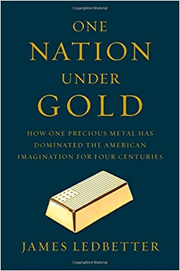Having been born after 1971, I have never lived in a time when the dollar was backed by gold. In an effort to learn more about the gold standard, I recently finished One Nation Under Gold: How One Precious Metal Has Dominated the American Imagination for Four Centuries by James Ledbetter. In other words, this is a history of gold in America. Here are my overall takeaways:
I always thought that the pre-1971 gold standard meant that for every dollar printed, there was a certain amount of gold set aside in a vault. This turns out to be false. A long time ago, gold coins actually circulated as currency. But the more modern version of a gold standard simply means the government agrees to sell gold bullion on demand at a fixed dollar price (ex. $35 for an ounce of gold).
Under the gold standard, countries rarely had enough gold in their vaults to cover if everyone decided to redeem their currency. As a result, countries including the United States were constantly worried about running out of gold and used various political tricks to prevent too many redemptions. If the fixed ratio was $35 an ounce and people could get the equivalent of $36 an ounce somewhere else, there would be a big spike in demand and the US would have to ship out tons of gold. If the vaults went empty, that could cause a financial crisis. The system was constantly under stress.
Every major currency has ended up being forced off the gold standard, usually in times of severe stress. Wars. International trade deficits. Economic depressions. In 1933, the US government was again running low on gold and so they devalued from $20.67/oz. to $35/oz (a devaluation of over 40%). In addition, they banned domestic individuals from owning gold from 1933-1974. (Hmmm… a gold standard where you couldn’t actually get gold…) In 1971, with both the Vietnam War and ongoing trade deficits, Nixon ended international convertibility of the US dollar to gold.
I’ve read that every fiat currency in history has eventually failed. Well, it’s also true that every gold standard in history has eventually failed. Just a thought that kept running through my head while reading this book. Gold-backed currency has its own set of problems.
Harry Browne: Wise investment mind or paid salesman for gold industry? You may have heard of Harry Browne as the creator the Permanent Portfolio: 25% stocks/25% cash/25% long-term bonds/25% gold. Well, this book mostly mentions Browne as a shady doomsday salesman for the gold industry. He wrote books that promoted a specific gold company (Pacific Coast Coin Exchange) and then got paid $100,000 (~$600,000 in 2017 dollars) by that company. That’s not all… The SEC shut down PCCE for having no actual gold in vaults and instead buying things like private jets with the money. Here is a 1974 NY Times article about the company.
The chance that the US goes back on a gold standard is very, very, very small. The gold standard did restrict governmental power, and some people like the sound of that. However, governments like having the ability to expand and contract the money supply to overcome stressful events like war and economic recessions. Will they wield that power wisely and effectively? Mistakes will be made, but I don’t see how they will voluntarily give up that flexibility. The question is not whether fiat currency is perfect, it is about which is better amongst imperfect options.
In the end, perhaps it is better that there is an open market for gold. Today, individuals can exchange gold for dollars and dollars for gold whenever they want. Gold ETFs let you buy gold with few clicks and lower transactional costs than physical gold. If you like market-cap weighting, consider a 1% gold portfolio.
I’m not a history buff in general, and perhaps that is why I found this book rather dry and hard to finish. There is no flowing narrative like a Michael Lewis book. However, I felt like I did learn some useful lessons and I’m glad I finished it.

 The Best Credit Card Bonus Offers – 2025
The Best Credit Card Bonus Offers – 2025 Big List of Free Stocks from Brokerage Apps
Big List of Free Stocks from Brokerage Apps Best Interest Rates on Cash - 2025
Best Interest Rates on Cash - 2025 Free Credit Scores x 3 + Free Credit Monitoring
Free Credit Scores x 3 + Free Credit Monitoring Best No Fee 0% APR Balance Transfer Offers
Best No Fee 0% APR Balance Transfer Offers Little-Known Cellular Data Plans That Can Save Big Money
Little-Known Cellular Data Plans That Can Save Big Money How To Haggle Your Cable or Direct TV Bill
How To Haggle Your Cable or Direct TV Bill Big List of Free Consumer Data Reports (Credit, Rent, Work)
Big List of Free Consumer Data Reports (Credit, Rent, Work)
What’s your take on bitcoin? I keep hearing that bitcoin could replace the fiat currency. I have yet to get involved in it but does interest me a bit.
Rob